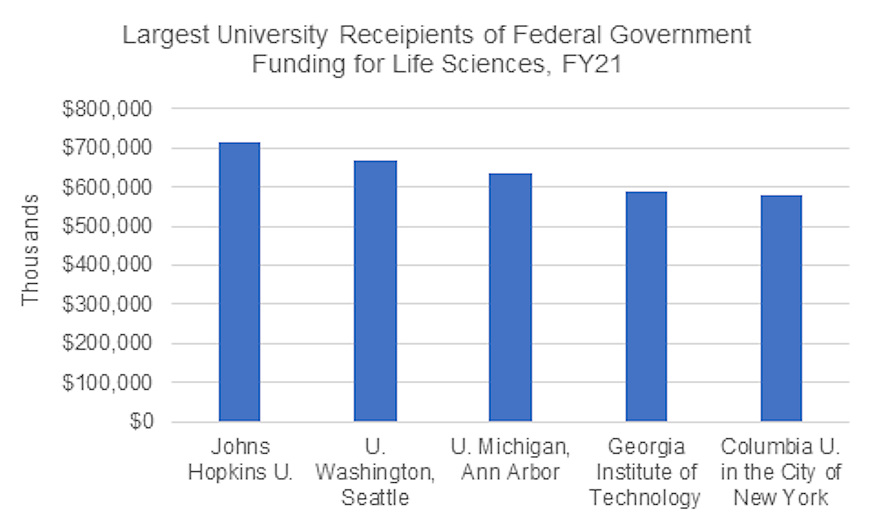February 23, 2022 -- Federally funded R&D for U.S. higher education universities grew 3.3% to $86.4 billion in fiscal year 2021 (FY21) (end-September 30, 2021), according to the latest statistics from the National Science Foundation. Funding from the federal government accounted for 53% of the total and increased 3.7%.
Federal R&D funding is highly concentrated among a small group of universities. Ten institutes accounted for 23% of all federal academic R&D funding in FY21. The university receiving the greatest amount was Johns Hopkins University, which alone accounted for 6% of the total federal amount, taking in $2.683 billion. Johns Hopkins and the University of Washington, Seattle each gained over $2 billion last fiscal year in federal funding.
| Three-year CAGR for the 5 universities receiving the most federal R&D funding | Ranking | University | Change |
| 1 | Johns Hopkins University | 6% |
| 2 | University of Washington, Seattle | 1.2% |
| 3 | University of Michigan, Ann Arbor | 1.4% |
| 4 | Georgia Institute of Technology | 6.5% |
| 5 | Columbia University in the City of New York | 3.6% |
Within the top 50 universities in terms of FY21 funding from the federal government, five universities recorded double-digit growth: Texas A&M University, College Station and Health Science Center (Texas A&M); the University of Texas, Austin (Austin); Indiana University, Bloomington (Indiana); the Georgia Institute of Technology; and the California Institute of Technology, with increases of 43.9%, 22.7%, 11.4%, 10.4%, and 10.2%, respectively. Funding dropped more than 2% for only one institution: Harvard University.
On a three-year combined annual growth average (CAGR), federal funding for all universities rose 3.3%. Texas A&M's funding increased the fastest, jumping 15.7%. This far outpaced Indiana, whose funding grew 11.4% and recorded the second-fastest CAGR. The other universities receiving the most federal funding on a three-year CAGR basis were Austin, Oregon Health & Science University, and Cornell University, with three-year CAGRs of 7.3%, 6.7%, and 6.1%, respectively.
Life sciences
The rankings of universities receiving R&D funding from the federal government reflected the significance of the life sciences. Life science R&D accounted for 56% of all federally funded R&D for universities in FY21. The top 11 universities ranked by life science federal funding each received more than $500 million and mirrors the rankings, given above the largest recipients for all fields.

Johns Hopkins University and the University of Washington, Seattle were the largest recipients of federal life science R&D funding for higher education last fiscal year at $714 million and $668 million, respectively. In fact, Johns Hopkins accounted for 27% of all federal life science funding for academia in FY21.
Tanya Samazan is managing editor of Instrument Business Outlook (IBO), a twice-monthly newsletter aimed at providing decision-makers with the latest and most complete information available on the life science and analytical instrument industry.
Disclosure: ScienceBoard is a sister company of IBO.
Do you have a unique perspective on your research related to life science research? Contact the editor today to learn more.
Copyright © 2022 scienceboard.net








